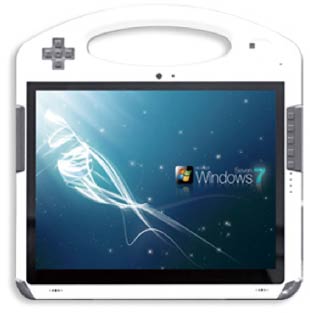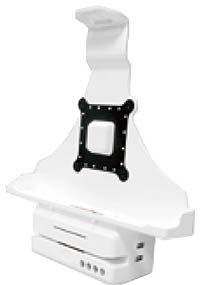It's been four years now that Intel introduced the Mobile Clinical Assistant, or MCA, concept, with the idea of creating a class of mobile computers designed and optimized for clinical environments where light weight, spill-resistance, the ability to absorb the occasional drop, and, most importantly, quick and easy cleaning and disinfection matter. Motion Computing was the first to pick up on the concept with its formidable C5. Panasonic and many others followed, including Arbor Technology of Taiwan which introduced its initial M1255 Mobile Clinical Assitant in early 2009. RuggedPCReview.com analyzed the M1255 (see here) and found much to like, including its Intel Atom-based architecture and its large 12.1-inch display. We were somewhat less impressed with the lack of an active digitizer, the modest stated battery life, and the degree of sealing and ruggedness.
Well, in January of 2011, Arbor introduced a second, or perhaps follow-up, model with the M1040 MCA.  Like the M1255, the new device loosely follows Intel's prototype with the signature integrated handle, clinical environment color scheme (white and gray), a minimum of onboard ports so as to eliminate nooks and crannies where germs could accumulate, and all sorts of data capture technologies such as scanners, RFID, camera, etc. And though it's hard to tell from the picture and even the specs, the new model has a smaller 10.4-inch display (which is what Intel's concept had in the first place) and not the M1255's 12-inch sceen.
Like the M1255, the new device loosely follows Intel's prototype with the signature integrated handle, clinical environment color scheme (white and gray), a minimum of onboard ports so as to eliminate nooks and crannies where germs could accumulate, and all sorts of data capture technologies such as scanners, RFID, camera, etc. And though it's hard to tell from the picture and even the specs, the new model has a smaller 10.4-inch display (which is what Intel's concept had in the first place) and not the M1255's 12-inch sceen.
The smaller screen means smaller dimensions, and the new M1040 indeed measures just 10 x 10 x 1 inches, which so happens to be almost exactly the same as the Motion C5v (and Intel's concept). Weight, though, is supposedly just 2.8 pounds with two batteries, and that is about half a pound less than the competition.
Has Arbor addressed the concerns we voiced in our assessment of their original MCA? For the most part, yes.
The display now offers dual input, with a resistive touch panel and an electromagnetic digitizer. That's definitely a good move as touch offers very quick ways to bring up menus and navigate through custom applications, while the digitizer pen allows for very precise input. The specs, however, do not indicate whether the system is auto-sensing. And, alas, time has moved on as well, with everyone now demanding projected capacitive touch as a result of the iPad's massive popularity.
As for ruggedness, the drop spec has been boosted from 2.5 to three feet. That's good and matches the major competition, but there's a reason why the MIL-STD-810G suggests four feet: when you hold a computing device in a standing position and drop it, it'll drop from about four feet, not three. The ingress protection rating stays at IP54, and there is no more "front panel only" qualifier. That would bring the M1040 up to the level of the competition.
Stated battery life remains at 3.5 hours. That's not very much for an Atom-based tablet with dual batteries, but since the specs do not indicate watt-hours, it's hard to judge efficiency. Also, most clinical tablets will likely never be far from an electrical outlet, and so battery life is not the same urgent issue as it'd be on a field service tablet.
Under the hood, Arbor upgraded the predecessor model's Atom N270 processor with the Atom N450 chip used in millions of second gen netbooks. That also means a switch to the corresponding ICH8M chipset and the N450's slightly improved graphics. There is one 200-pin SODIMM slot that now comes with a 2GB DDR2-667 RAM module installed. The standard disk is a 1.8" 120GB SATA model, or you can opt for a 32GB solid state disk. There is Bluetooth and a 802.11 WiFi mini-PCIe card that supports 802.11b/g/n, and an optional 3.75G HSUPA WWAN odule.
 As was the case with the M1255, things are not entirely clear on the battery and power side. There is mention of an internal 3-cell battery and also an external hot-swappable battery. Unfortunately, there are no pictures that show how the arrangement works, and whether the stated battery life is with one or both batteries.
As was the case with the M1255, things are not entirely clear on the battery and power side. There is mention of an internal 3-cell battery and also an external hot-swappable battery. Unfortunately, there are no pictures that show how the arrangement works, and whether the stated battery life is with one or both batteries.
MCA usually do not have onboard connectors because a) they don't need them as they are usually used with a docking station, and b) ports make a device more prone to attracting dirt and bacteria, and they are more difficult to clean. The documentation does not describe anti-bacterial properties, whether there's a fan or not, and what the backside looks like. Without that information, it's difficult to determine if the M1040 is easy to clean and disinfect. As is, there is an onboard USB port and a docking connector that works in conjunction with the VMC-1040 cradle that uses RAM-Mount components for easy mounting just about anywhere. The cradle has four USB ports, an RJ45 LAN jack, a serial port, VGA, and even a Smart Card and magstripe reader.
For operation, the M1040 has more buttons and controls than most tablets. There's a 5-way navigation pad, and buttons for locking the display, record, start video, capture pictures, read RFID tags, scan barcodes, select language, record sound, as well as power and SAS (Secure Attention Sequence, also known as Ctl-Alt-Del).
Data capture is an important part of these clinical tablets, and so the M1040 has an integrated 2D barcode scanner, integrated RFID reader, as well as two integrated 2-megapixel cameras for conferencing and documentation purposes.
How does this latest Arbor MCA measure up? With its 10.4-inch display it's closer to the original Intel MCA concept than the larger M1255. It is well equipped and we appreciate the dual mode input. The optional docks (see docks PDF) are well designed and very functional. Available documentation is marginal and so we cannot conclusively comment on battery life, ruggedness and ease of cleaning.
Overall, if the price is right, the Arbor M1040 may make a very attractive OEM/ODM deal for distributors, VARs and system integrators.



